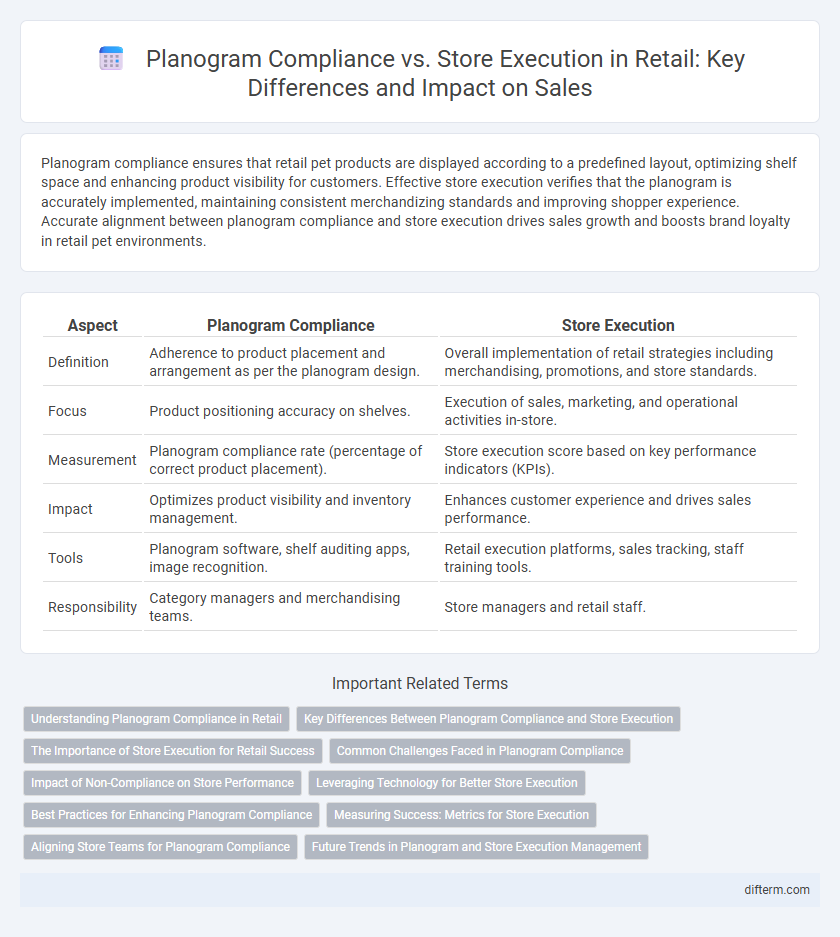Planogram compliance ensures that retail pet products are displayed according to a predefined layout, optimizing shelf space and enhancing product visibility for customers. Effective store execution verifies that the planogram is accurately implemented, maintaining consistent merchandizing standards and improving shopper experience. Accurate alignment between planogram compliance and store execution drives sales growth and boosts brand loyalty in retail pet environments.
Table of Comparison
| Aspect | Planogram Compliance | Store Execution |
|---|---|---|
| Definition | Adherence to product placement and arrangement as per the planogram design. | Overall implementation of retail strategies including merchandising, promotions, and store standards. |
| Focus | Product positioning accuracy on shelves. | Execution of sales, marketing, and operational activities in-store. |
| Measurement | Planogram compliance rate (percentage of correct product placement). | Store execution score based on key performance indicators (KPIs). |
| Impact | Optimizes product visibility and inventory management. | Enhances customer experience and drives sales performance. |
| Tools | Planogram software, shelf auditing apps, image recognition. | Retail execution platforms, sales tracking, staff training tools. |
| Responsibility | Category managers and merchandising teams. | Store managers and retail staff. |
Understanding Planogram Compliance in Retail
Planogram compliance in retail measures how accurately store shelves match the planned product layout designed to maximize sales and enhance the shopping experience. Ensuring high planogram compliance improves inventory management, product visibility, and customer satisfaction by maintaining consistent brand representation. Effective store execution hinges on regular audits, employee training, and built-in technology solutions to monitor and enforce adherence to planogram standards.
Key Differences Between Planogram Compliance and Store Execution
Planogram compliance measures how accurately store shelves match predefined layouts to optimize product placement and boost sales, while store execution encompasses broader operational activities including merchandising, inventory management, and customer service to ensure overall store performance. Planogram compliance focuses specifically on visual merchandising standards and shelf organization, whereas store execution involves implementing strategic plans across multiple functions to enhance the shopping experience. Understanding these key differences helps retailers prioritize tasks that drive both shelf efficiency and operational excellence.
The Importance of Store Execution for Retail Success
Store execution directly impacts planogram compliance by ensuring products are placed and displayed accurately, driving sales and enhancing customer experience. Effective store execution involves regular audits, staff training, and adherence to merchandising standards to maintain consistent brand presentation across locations. Retailers that prioritize execution see improved inventory management, reduced stockouts, and stronger shopper engagement, all critical for sustained revenue growth.
Common Challenges Faced in Planogram Compliance
Store execution often grapples with maintaining strict planogram compliance due to frequent inventory discrepancies and inconsistent product placement across aisles. Retailers face challenges such as limited staff training, time constraints during restocking, and variability in planogram interpretation. These issues lead to reduced shelf integrity, impacting sales performance and customer experience.
Impact of Non-Compliance on Store Performance
Non-compliance with planogram standards disrupts product placement, leading to reduced shelf visibility and poor inventory management that directly hampers sales performance and customer satisfaction. Inconsistent store execution results in missed promotional opportunities and diminished brand integrity, which negatively affect overall revenue and market competitiveness. Studies show that retailers experiencing high planogram compliance rates report up to 15% greater sales growth compared to those with frequent execution discrepancies.
Leveraging Technology for Better Store Execution
Leveraging advanced technology such as AI-powered planogram compliance tools and real-time analytics enhances store execution by ensuring accurate product placement and inventory management. Mobile devices and IoT sensors facilitate immediate issue detection and corrective actions, driving operational efficiency and consistent customer experiences. Integrating these digital solutions fosters data-driven decision-making that optimizes merchandising strategies and maximizes sales performance.
Best Practices for Enhancing Planogram Compliance
Effective planogram compliance in retail hinges on precise store execution strategies that ensure products are displayed according to the planogram specifications. Utilizing technologies such as shelf-scanning robots and mobile auditing apps enhances real-time monitoring, enabling swift corrective actions to maintain accuracy. Training store associates on visual merchandising standards and implementing regular compliance audits optimize shelf layout adherence, directly boosting sales and customer satisfaction.
Measuring Success: Metrics for Store Execution
Measuring success in store execution requires tracking key metrics such as planogram compliance rates, shelf availability, and product placement accuracy. High planogram compliance ensures consistent brand presentation and can drive increased sales by optimizing product visibility and customer experience. Store execution metrics must also include customer engagement data and inventory turnover to assess operational efficiency and identify areas for improvement.
Aligning Store Teams for Planogram Compliance
Aligning store teams for planogram compliance is critical to ensure consistent product placement that maximizes sales and enhances customer experience. Effective communication and regular training sessions empower employees to understand planogram standards, reducing deviations and improving inventory accuracy. Utilizing technology such as mobile audits and real-time feedback systems reinforces adherence and drives operational efficiency across retail locations.
Future Trends in Planogram and Store Execution Management
Emerging technologies such as AI-driven analytics and real-time shelf monitoring are transforming planogram compliance, enabling retailers to optimize store execution with greater precision and agility. Integration of IoT sensors and mobile apps allows for continuous data collection, enhancing inventory accuracy and merchandising consistency while reducing human error. Future trends emphasize predictive modeling and automated adjustments, driving more dynamic and responsive retail environments that improve shopper experience and sales performance.
Planogram Compliance vs Store Execution Infographic

 difterm.com
difterm.com